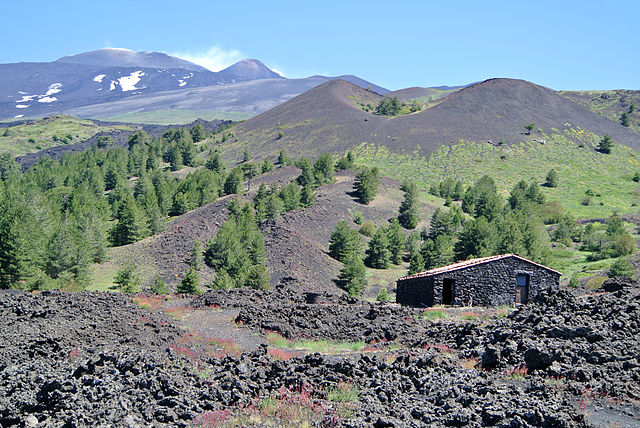Mount Etna, or simply Etna, is an active stratovolcano on the east coast of Sicily, Italy, in the Metropolitan City of Catania, between the cities of Messina and Catania. It is located above the convergent plate margin between the African Plate and the Eurasian Plate. It is one of the tallest active volcanoes in Europe, and the tallest peak in Italy south of the Alps with a current height of 3,357 m (11,014 ft), though this varies with summit eruptions. Over a six-month period in 2021, Etna erupted so much volcanic material that its height increased by approximately 100 ft (30 m), and the southeastern crater is now the tallest part of the volcano.
Etna with the city of Catania in the foreground (December 2007)
February 2021 eruption seen from Naval Air Station Sigonella
Mount Etna from the south with the smoking peak in the upper left and a lateral crater in the centre
An artist's impression of the 1766 eruption
A stratovolcano, also known as a composite volcano, is a conical volcano built up by many layers (strata) of hardened lava and tephra. Unlike shield volcanoes, stratovolcanoes are characterized by a steep profile with a summit crater and periodic intervals of explosive eruptions and effusive eruptions, although some have collapsed summit craters called calderas. The lava flowing from stratovolcanoes typically cools and solidifies before spreading far, due to high viscosity. The magma forming this lava is often felsic, having high to intermediate levels of silica, with lesser amounts of less viscous mafic magma. Extensive felsic lava flows are uncommon, but have traveled as far as 15 km (9 mi).
Mount Rainier, a 4,392 m (14,411 ft) stratovolcano, the highest point in the US state of Washington
Exposed internal structure of alternating layers of lava and pyroclastic rock in the eroded Broken Top stratovolcano in Oregon
Mount Etna on the island of Sicily, in southern Italy
Snow-like blanket of Mount Pinatubo's ashfall deposits in a parking lot on Clark Air Base (June 15, 1991)








